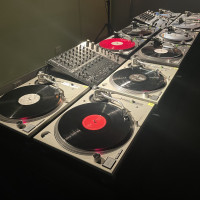GENERIC SOUNDS
The »generic« refers to that which belongs to a large group, the genus, »shared by, including or typical of a whole group of things« (Oxford Dictionary). It is the paradoxical quality of having »no particularly distinctive quality« (Merriam-Webster). Hence, the generic is defined in opposition to anything specific, individual, distinct, characteristic, personal. It is anybody, anything, anywhere, anytime – and therefore nothing in particular. How does that sound? What are the qualities of sounds without qualities? Unspecific, trivial, typical sounds?
Indeed, to distinguish what is specific and what is generic in today’s soundscapes has become a complex issue. Still, however, we spontaneously invest sounds with certain values and affective capacities on the basis of this distinction, which makes it continuously effective and relevant. Generic sound has often been disregarded as a sign of commercialization, standardization and as an enemy of the ‘authentic’ human qualities of individual expression and interpersonal communication.
But on the other hand, the generic is widely acknowledged as a ubiquitous and inescapable part of the modern soundscape (Chion 2016). Generic features such as imitation and variation, standard formats and typical forms of expression, reproduction, circulation and serial distribution are arguably defining factors in shaping how contemporary sonic arts, sound design and sonic communication function in a commercialized, mediatized and globalized culture. The sonically specific, personal and distinct is, in a sense, always haunted by the generic – for good or for worse.
In this issue, we are pleased to present eight audio papers and written articles by scholars and artists from various disciplines, exploring the overall topic of generic sounds from a wide range of perspectives – from medieval voice silencing instruments to AI voices, from ping signals to Muslim calls to prayer, from aural gentrification of urban space to public sonic alerts, from locked grooves to sonic datafication.
In the audio paper, A Slight Case of Self: Synthetic Voices and Postmodern Subjectivities, Berlin-based musician and musicologist Katharina Schmidt explores the generic characteristics of AI-generated voices in current digital culture. By mixing different synthetic voices into a simultaneously synthetic and oddly realistic sounding choir, she explores how synthetic voice generation disturbs notions of intentionality, subjectivity, communication and being.
Dutch artist and researcher Luca Soudant’s audio paper, Resonant Gender Performativity: Thinking Through a Feedbacking Scold’s Bridle, presents a fascinating contemporary perspective on the historical voice-silencing instrument, the scold’s bridle. Constructing a replica of the instrument to record its subtle resonances, Soudant embarks on an auto-ethnographic exploration into the violence of misogynic sonic control and the uncanny generic aesthetics associated with gendered voice-silencing.
In the written article, Notes on Ping, British artist and researcher Louise K. Wilson explores the onomatopoeic sound-word ‘ping’ and its ubiquitous presence in modern sonic and auditory culture. From marine soundscapes, laboratories and everyday workspaces to Monty Python and Samuel Beckett, Wilson explores ping’s generic, yet heterogeneous, material manifestations and the complex cultural imaginaries associated with it.
In the audio paper, Azan, A Call To Prayer: Generic or Artistic?, Malaysian musician and researcher Pei Ann Yeoh delves into the Azan, the Muslim call to prayer, as both a generic and specific sonic expression of the urban soundscape in Muslim countries. Using field recordings, Yeoh explores the cultural and perceptual implications of the Azan and its repetitive omnipresence as it blends with the city’s other sonic activities.
The audio paper, A City We Can Get up and Go to Work in: Contesting the Genre of the Urban Soundscape by British sound scholar and cultural theorist Macon Holt, is an explorative sonic investigation of relations between ideals of generic sound, work ethics, politics of noise regulation and sonic gentrification in the urban area of Nørrebro, Copenhagen, and a critical reflection on the Danish government’s recent considerations towards legislation of soundscapes in urban areas in Copenhagen.
The audio paper, Noisy Interference in the Becoming-Generic of Sonic Alerts, by the collective sound braid investigates the possibility that everyday sonic alarms become generic entities that ordain sonic signals into forms of social management. An investigation made through the spoken cases and samples of alerts and field recordings captured in the Americas.
In the audio paper, When generic sounds become data, Ilaria Gadenz (Radio Papesse) and Giulia Mengozzi (ALMARE) question the idea of »generic sounds« in relation to the ever-growing datafication of the mundane. In a surveillance perspective they investigate how voice-enabled technologies and algorithmic listening and recording in domestic settings impact the relationship between acoustic space and digital infrastructure.
Australian DJ, producer, lecturer and researcher Mike Callander’s audio paper, Locked Grooves: Affordances and Limitations within a Record’s Revolution, investigates how the looping of locked grooves and skipping on vinyl records can be transformed into new unique artistic expressions. Through historical examples and his own DJ practice, Callander explores the relationship between the unique and the generic in different media-specific contexts.
With this multifaceted collection, we hope to give new perspectives on the immense historical and contemporary influences of generic sound on our sonic cultures, societies and arts – and inspire future explorations.
All contributions are peer reviewed by anonymous reviewers and edited before publication. Thanks to all authors, submitters, reviewers and technical assistants for your interest and careful work!
Morten Riis and Ulrik Schmidt







